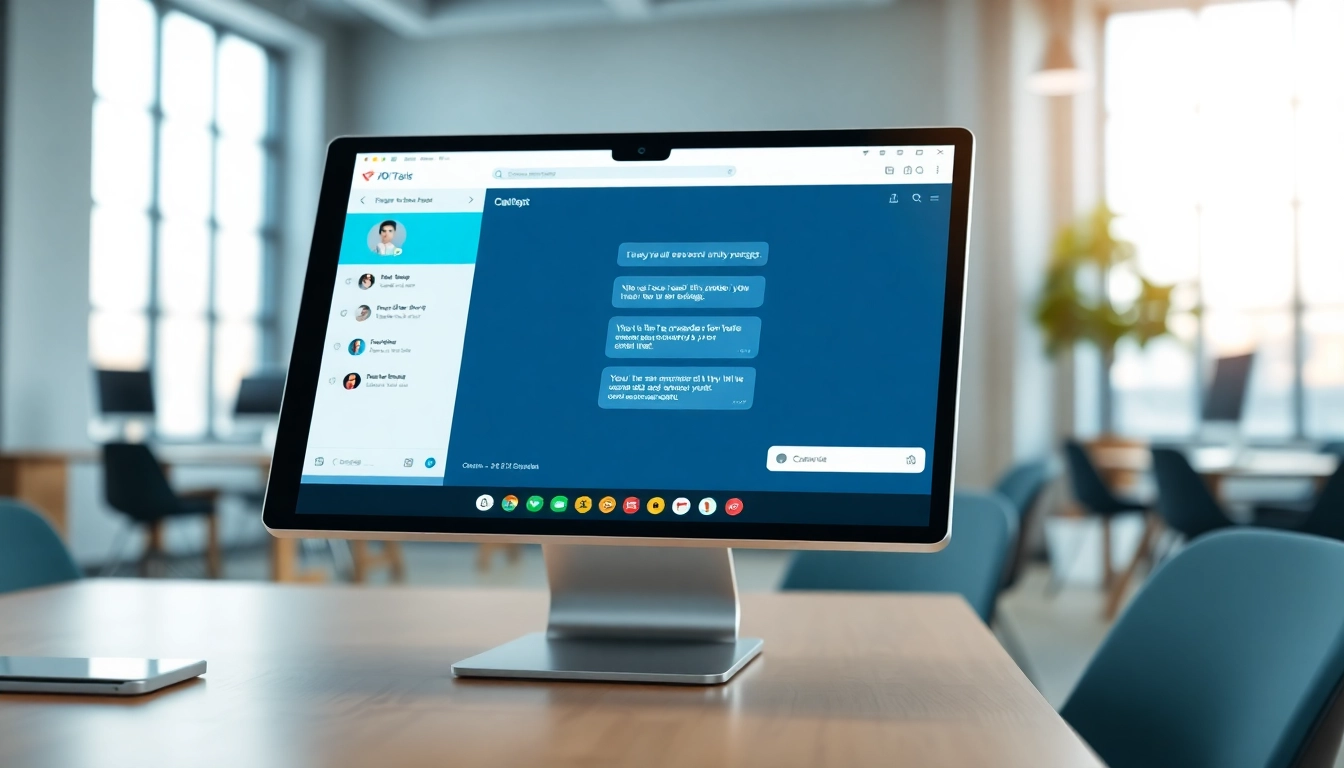Introduction to AI Chatbots for Websites
In today’s digital landscape, businesses are continually searching for efficient ways to engage with customers and streamline their operations. One of the most effective solutions that has emerged is the use of AI chatbots on websites. An AI chatbot for website can transform user interaction, making it more seamless and personalized. But what exactly are AI chatbots, and what makes them a vital tool for online businesses? This article explores the ins and outs of AI chatbots, their benefits, implementation strategies, and future trends.
What is an AI Chatbot?
An AI chatbot is a software application designed to conduct conversations with human users, especially over the Internet. Powered by artificial intelligence, these chatbots can interpret user queries, provide relevant responses, and facilitate transactions. Unlike traditional chatbots, which rely solely on scripted responses, AI chatbots can utilize machine learning and natural language processing to enhance their conversational abilities, making them more efficient over time.
Key Benefits of Using AI Chatbots
There are multiple advantages to integrating AI chatbots into your website:
- 24/7 Availability: AI chatbots operate around the clock, ensuring that customers receive assistance anytime they need it, boosting engagement and satisfaction.
- Cost Efficiency: Businesses can reduce operational costs by automating customer service tasks, allowing human agents to focus on complex issues.
- Personalized User Experiences: Advanced chatbots can analyze user data and preferences, delivering tailored responses that resonate with individual users.
- Scalability: As your business grows, AI chatbots can handle increasing volumes of interactions without a decrease in performance.
- Improved Lead Generation: By engaging visitors in real-time, chatbots can capture lead information and guide users through the sales funnel efficiently.
Understanding User Intent with AI Chatbots
One of the fundamental aspects of effective communication is understanding user intent. AI chatbots utilize natural language processing to analyze user input and interpret the intent behind the queries. This capability allows chatbots to provide relevant answers, recommend solutions, or escalate matters to human agents when necessary. The better a chatbot understands user intent, the more helpful it becomes in guiding the user toward resolution.
Choosing the Right AI Chatbot for Your Website
Selecting the appropriate AI chatbot for your website is a critical decision that can significantly impact user experience and operational efficiency. Below are some essential factors to consider when making this choice.
Factors to Consider When Selecting a Chatbot
When choosing an AI chatbot, consider the following:
- Compatibility: Ensure that the chatbot integrates seamlessly with your existing systems and platforms, such as CRMs and helpdesk software.
- Customization Options: Select a chatbot that allows for customization to reflect your brand’s tone and personality.
- Natural Language Processing Capabilities: A good chatbot should effectively understand and respond to various phrases and dialects.
- Analytics and Reporting Features: Choose a chatbot that provides insights into conversation trends and user engagement metrics.
- User Reviews and Case Studies: Research feedback from other users to understand how the chatbot performs in real-world applications.
Top AI Chatbot Platforms Compared
There are several AI chatbot platforms available, each with its unique features and advantages. Here’s a comparison of some of the most popular options:
| Platform | Key Features | Best For |
|---|---|---|
| Dialogflow | Natural language understanding, Integration with Google services | Businesses looking for advanced NLP capabilities |
| Chatfuel | No coding required, Visual flow builder | Non-technical users and marketers |
| ManyChat | Focus on Facebook Messenger, Marketing automation | Businesses focused on social media engagement |
| Drift | Lead generation tools, Live chat integration | Sales teams and B2B companies |
Custom vs. Off-the-Shelf Solutions
When selecting a chatbot, one of the primary decisions will be between custom-built and off-the-shelf solutions. Custom chatbots are tailored to the unique requirements of your business, allowing for extensive personalization. However, they can be costly and time-consuming to develop. Off-the-shelf solutions are typically more economical and require less time to implement but may lack the specific features that your business needs. Consider your budget, timeline, and specific requirements when making this decision.
Implementing AI Chatbots Effectively
Once you’ve selected an AI chatbot, the next step is to implement it effectively on your website. Here, we’ll discuss best practices for integrating chatbots, designing conversational flows, and training them to ensure optimal performance.
Best Practices for Chatbot Integration
Integrating a chatbot into your website doesn’t have to be complicated. Here are some best practices to follow:
- Clear Placement: Position the chatbot in a visible part of your website, typically at the bottom right corner, to make it easily accessible.
- Test Before Launch: Conduct thorough testing to ensure that the bot functions as expected and provides accurate responses.
- Provide User Guidance: Create a brief introduction or tooltip that explains the chatbot’s functionalities to users.
- Maintain a Human Touch: Incorporate an option for users to connect with a human agent if needed, especially for complex inquiries.
Designing Conversational Flows
A well-designed conversational flow enhances user experience. When designing these flows, consider the following:
- Start with Common Queries: Identify frequently asked questions and ensure the chatbot can handle them effectively.
- Use Personalization: Tailor conversations based on user interactions and preferences.
- Encourage Engagement: Design prompts that encourage the user to continue the conversation or explore additional features.
- Simplify Language: Use simple, clear language that matches your audience’s reading level.
Training Your Chatbot for Optimal Performance
Training your AI chatbot is crucial for achieving optimal performance. This process involves providing the chatbot with data and examples to help it learn from real conversations. Regularly update training data with new information to improve its accuracy and effectiveness. Additionally, monitor performance and adjust training based on user interactions and outcomes.
Measuring Success of Your AI Chatbot
To ensure that your chatbot is delivering value, it’s essential to measure its success effectively. This involves tracking key performance indicators, gathering user feedback, and analyzing case studies of successful implementations.
Key Performance Indicators (KPIs) to Track
Monitoring KPIs can help you understand how well your chatbot is performing. Here are some critical KPIs to consider:
- User Engagement Rate: Measure how many users interact with the chatbot compared to the total website visitors.
- Conversion Rate: Track how many users complete desired actions, such as signing up for a newsletter or making a purchase, after interacting with the chatbot.
- Response Accuracy: Evaluate the percentage of queries that the bot handles successfully without human intervention.
- User Satisfaction Scores: Conduct surveys or utilize ratings after interactions to assess user satisfaction levels.
Gathering User Feedback and Iteration
User feedback plays a significant role in the continuous improvement of your chatbot. Regularly solicit insights from users about their experience, and implement changes based on their suggestions. This iterative process helps refine the chatbot’s capabilities and ensures it remains relevant to user needs.
Case Studies: Successful AI Chatbot Implementations
Examining successful case studies can provide valuable insights into effective AI chatbot implementations. For instance:
- Sephora: The beauty retailer implemented a chatbot that offers personalized product recommendations. By utilizing data from past purchases and browsing behavior, Sephora’s chatbot can craft tailored suggestions that enhance the shopping experience.
- H&M: H&M’s chatbot helps users find outfits based on their preferences and sizes, significantly reducing the time spent searching for products and improving customer satisfaction.
- Bank of America: The bank employs an AI chatbot named Erica, which provides financial advice and helps customers manage their accounts. Erica has improved customer interaction and lowered call volume to customer service representatives.
Future Trends in AI Chatbots
The landscape of AI chatbots is continually evolving. To stay competitive, it’s crucial to understand the future trends shaping this technology.
AI Chatbots and Human Interaction
While AI chatbots are becoming increasingly sophisticated, the importance of human interaction remains undeniable. Future chatbots are likely to be designed for seamless handovers to human agents when necessary, ensuring that complex or emotionally charged inquiries can be addressed effectively. This hybrid model combines the efficiency of AI with the empathy and understanding of human agents.
The Role of Machine Learning in Chatbot Evolution
Machine learning is at the core of chatbot evolution. As AI chatbots process more data, they will learn to understand context, sentiment, and user intent better. This advancement will lead to more meaningful conversations and personalized interactions, enhancing the overall customer experience.
Predictions for the Future of Chatbots on Websites
The future of chatbots on websites is promising. Predictions suggest an increase in voice-activated chatbots, making interaction even more intuitive. Moreover, advancements in AI will likely see chatbots being integrated more deeply into websites, such as by managing video calls or handling complex customer journeys without user input. As technology advances, chatbots will become integral components of the online user experience.








